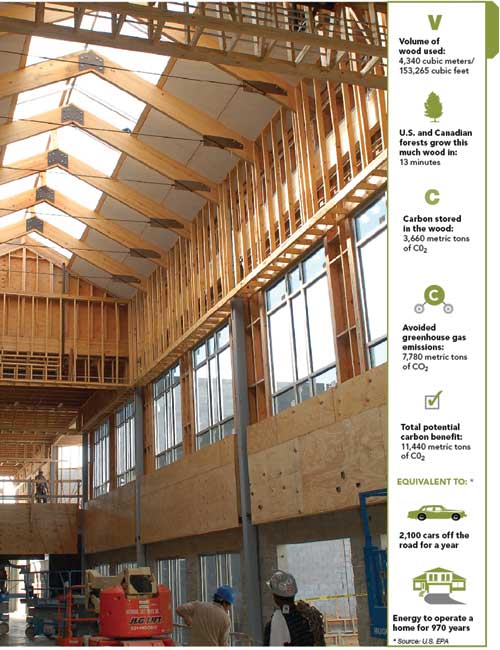Calculating Carbon Footprint
Wood Has Low Embodied Impacts
Embodied energy—which is the energy required to harvest, manufacture, transport, install, maintain, and dispose or recycle a material—also contributes to wood's light carbon footprint. Life cycle assessment (LCA) studies, which consider the environmental impacts of materials over their entire lives, consistently show that wood performs better than other materials in terms of embodied energy, air and water pollution, and greenhouse gas emissions.
One of the reasons wood performs well is that it requires far less energy to manufacture than other materials10—and very little fossil fuel energy, since most of the energy used comes from converting residual bark and sawdust to electrical and thermal energy. For example, the production of steel, cement, and glass requires temperatures of up to 3,500°F, which is achieved with large amounts of fossil fuel energy. On average, the U.S. and Canadian forest industries generate about 65 percent and 60 percent of their energy needs (respectively) from sources other than fossil fuels.
A comprehensive review of scientific literature examined research done in Europe, North America, and Australia pertaining to life cycle assessment of wood products.11 It applied life cycle assessment criteria in accordance with ISO 14040-42 and concluded, among other things, that:
- Fossil fuel consumption, potential contributions to the greenhouse effect, and the quantities of solid waste tend to be minor for wood products compared to competing products.
- Wood products that have been installed and are used in an appropriate way tend to have a favorable environmental profile compared to functionally equivalent products made out of other materials.
Increasingly, architects and engineers are utilizing LCA as an objective way to compare the environmental impacts of their material choices. The number of LCA databases for building materials and products, and tools for calculating their impact, is growing. For example, the Consortium for Research on Renewable Industrial Materials (CORRIM) undertakes LCA research, concentrating on U.S. products and materials.
In 2005 and 2010, CORRIM published the results of two phases of a landmark study comparing wood-frame and steel-frame homes in Minneapolis and wood-frame and concrete homes in Atlanta (the building types most common in those parts of the country). Phase II placed an emphasis on carbon footprint, and confirmed that the carbon stored in wood products offsets many of the emissions from other products. Despite the small total mass difference resulting from substituting steel or concrete framing for wood, the Global Warming Potential (CO2 equivalent of greenhouse gas emissions, including CO2, methane, and nitrous oxide) from the steel-framed house was 26 percent greater than the house with wood walls and floors, without considering the carbon stored in the wood products. This became a 120 percent difference when the carbon stored in the wood products for the life of the house was included. Emissions from the completed, concrete wall-framed house were 31 percent greater than the wood wall house without considering the carbon stored in wood products, and 156 percent greater when these carbon stores were included in the calculation.
 |
|
Source: Utilization of Harvested Wood by the North American Forest Products Industry, Dovetail Partners, Inc. |
The Athena Sustainable Materials Institute undertakes similar research and also develops and maintains LCA tools for use by North American building designers. The Athena Impact Estimator for Buildings is a robust, easy-to-use software tool for evaluating the environmental footprint of whole buildings and building assemblies. The Athena EcoCalculator is a simplified version with pre-calculated assemblies in a spreadsheet format. Both tools use internationally recognized LCA methods in the background. The EcoCalculator is available free from the Athena Sustainable Materials Institute.
Project: El Dorado High School El Dorado High School was one of the first schools in Arkansas to make extensive use of wood following a 2009 change in policy that had prohibited wood in school construction. The school was originally designed in steel and masonry, but came in over budget. By switching to wood framing, the project team saved $2.7 million.12 |










